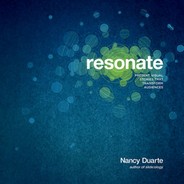170 Resonate
A presentation broadcasts information to an audience
in much the same way that a radio broadcasts pro-
gramming to listeners. Thus, the signal’s strength and
clarity determine how well information is conveyed to
its intended recipients. Communication is a complex
process that has many points at which the signal can
break down. Once a message has left its sender, it is
susceptible to interference and noise, which can cloud
its intention and compromise the recipient’s ability to
discern the meaning.
Communication has the following parts: sender, trans-
mission, reception, receiver, and noise. The message can
become distorted at any step of this process. Your top
priority is to ensure that the message-carrying signal is
free from as much noise or interference as possible.
Presentation development works the same way. Every
step of the process either enhances the signal or creates
noise that causes the audience to tune out.
My own high-tech career began in 1984 selling custom
high-frequency cable assemblies. Each cable was cus-
tom engineered to meet an extensive list of specifica-
tions. The task of every engineer and plant employee
was to ensure that each step in the manufacturing
process reduced the noise margin and protected the
Amplify the Signal, Minimize the Noise
signal’s quality. We tested raw materials, insulated wire
with advanced materials, and produced gold-plated ter-
minators. We fussed over everything at each stage and
then tested everything before it was shipped. If it didn’t
fall within a tight impedance tolerance, we couldn’t ship
it, because it wouldn’t work for the client’s application.
One small error would render the cable useless.
The same is true for creating a great presentation. The
signal-to-noise ratio is an important factor in how well
your message is received, and it’s your job to minimize
the noise. If the audience receives a message that includes
any interference, they receive distorted information. You
must expend energy minimizing the noise in each step of
the communication process to ensure that a crystal-clear
message gets through to your audience.
There are four main types of noise that can interfere
with your signal: credibility, semantic, experiential, and
bias noise. The graphic to the right shows where the
various types of noise occur in communication. Your
job is to minimize the noise as much as possible at each
step of the process.
This section will address some of the factors that create
noise. Noise can be reduced or eliminated through care-
ful planning and rehearsing.
CH008.indd 170CH008.indd 170 8/16/10 6:15:36 PM8/16/10 6:15:36 PM

There's Always Room to Improve 171
The Role of Noise in Communication
1
SENDER
RECEIVER
TRANSMISSION
RECEPTION
BIAS NOISE
Speaker lters idea
through bias or
dogmatism
Self-centered
material
Interpretation of
message is askew
Fallacies imbued
into message
SEMANTIC NOISE
Language and
interpretation create
interference
Use of too
much jargon
Too many ller
words like “um”
Visual language
is distracting
EXPERIENTIAL
NOISE
Speaker’s delivery
or venue creates
interference
Presentation
goes long
Distracting body
language
Unprepared and
unrehearsed
Poor environment
CREDIBILITY
NOISE
Speaker’s believ-
ability or likability
creates interference
Negative rst
impression
No common
ground
Imbalance in
emotional appeal
Credibility not
established
BIAS NOISE
Receiver lters idea
through bias or
dogmatism
Antagonistic
Hasty judgement
Rigid mindset
Easily offended
You cannot control
audience interpretation,
but by knowing them,
you can circumvent
some bias noise.
Idea received
Original idea
CH008.indd 171CH008.indd 171 8/16/10 6:15:40 PM8/16/10 6:15:40 PM
..................Content has been hidden....................
You can't read the all page of ebook, please click here login for view all page.
